Key takeaways:
- Understanding the context of security alerts is crucial to differentiate between genuine threats and noise, enabling more effective responses.
- Establishing prioritization criteria based on urgency, severity, and context helps manage alerts efficiently and reduce stress during critical moments.
- Utilizing automation and machine learning enhances alert management, improves accuracy, and enables quicker responses to potential threats.
- Documenting findings and actions fosters team accountability, aids in refining processes, and supports the learning and development of security practices.
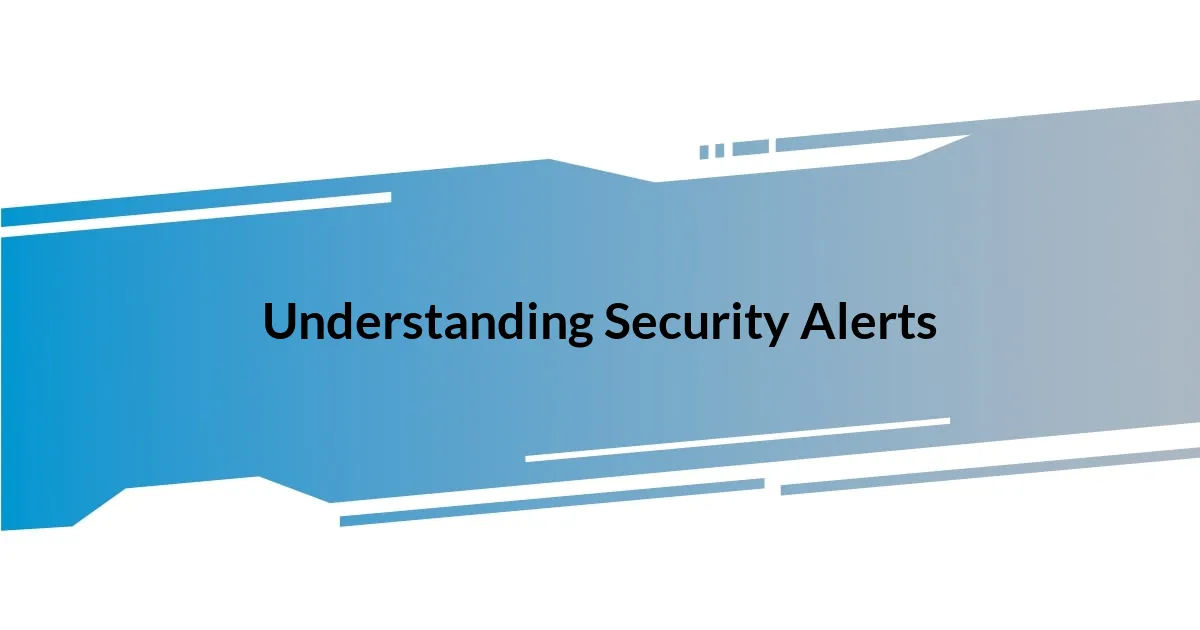
Understanding Security Alerts
Security alerts can often feel overwhelming, especially when they flood in during a critical moment. I remember a time when I received multiple alerts simultaneously, and my heart raced as I tried to process them all. It made me realize the importance of staying calm and understanding each alert’s context before taking action.
When I encounter a security alert, I always ask myself: what specific threat does this alert represent? This question forces me to dig deeper into the details rather than just scanning for panic signals. I once overlooked a seemingly minor alert that turned out to be a precursor to a significant breach. Learning to differentiate the noise from genuine threats can make all the difference.
Moreover, I find that categorizing alerts based on their potential impact helps me respond more efficiently. For instance, distinguishing between alerts that stem from system vulnerabilities and those related to user behavior changes has guided my response strategies. It’s a bit like prioritizing a fire drill over a spilled drink—both need attention, but some require immediate action.
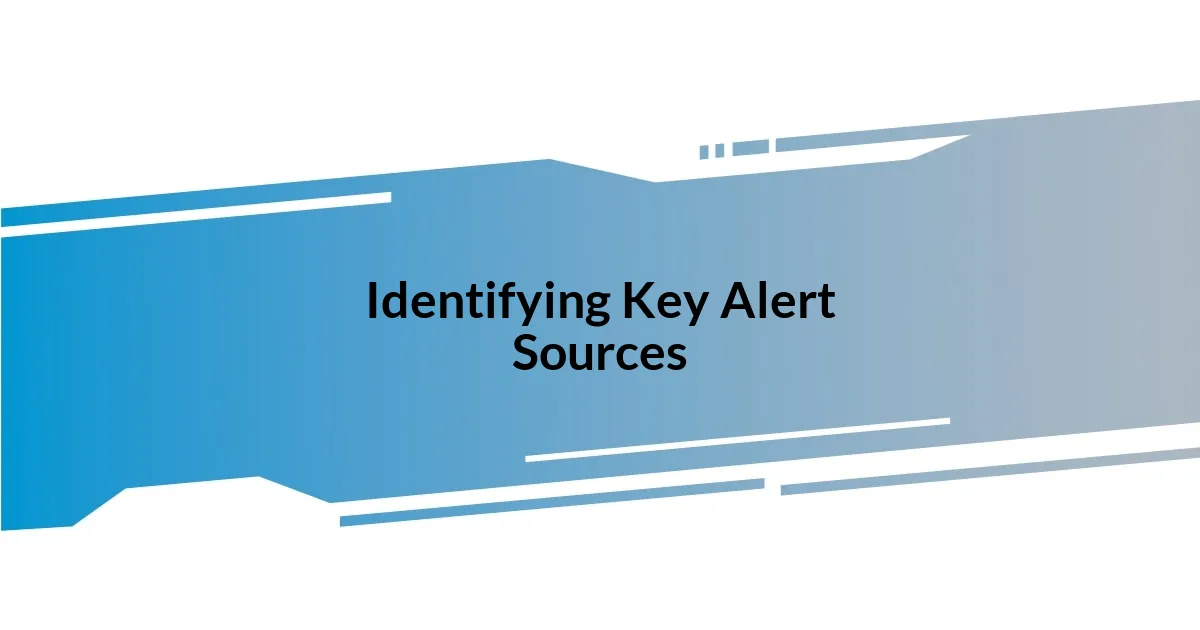
Identifying Key Alert Sources
Integrating my experience into identifying key alert sources has been pivotal in managing security risks effectively. I focus on the origin of each alert—whether they are from intrusion detection systems, network logs, or endpoint security tools. One day, while sifting through routine notifications, I came across an alert from a new device attempting to access our network. My gut instinct told me to investigate further, and it led to discovering a compromised employee account. This incident reinforced my belief that understanding where alerts are generated can significantly sharpen my response.
To streamline this process, I target specific key alert sources and evaluate their context:
- Intrusion Detection Systems (IDS) – These provide alerts on potential unauthorized access attempts.
- Firewall Logs – Monitoring network traffic helps identify anomalies before they escalate.
- Endpoint Security Solutions – Alerts from antivirus or endpoint detection systems can indicate harmful activity on individual workstations.
- User Behavior Analytics (UBA) – These highlight unusual patterns in user behavior that could signal a breach.
- Third-Party Integrations – I keep an eye on alerts from external vendors or cloud services handling sensitive data.
Making sense of alerts starts with these sources, ensuring that I’m not just reacting, but acting strategically.
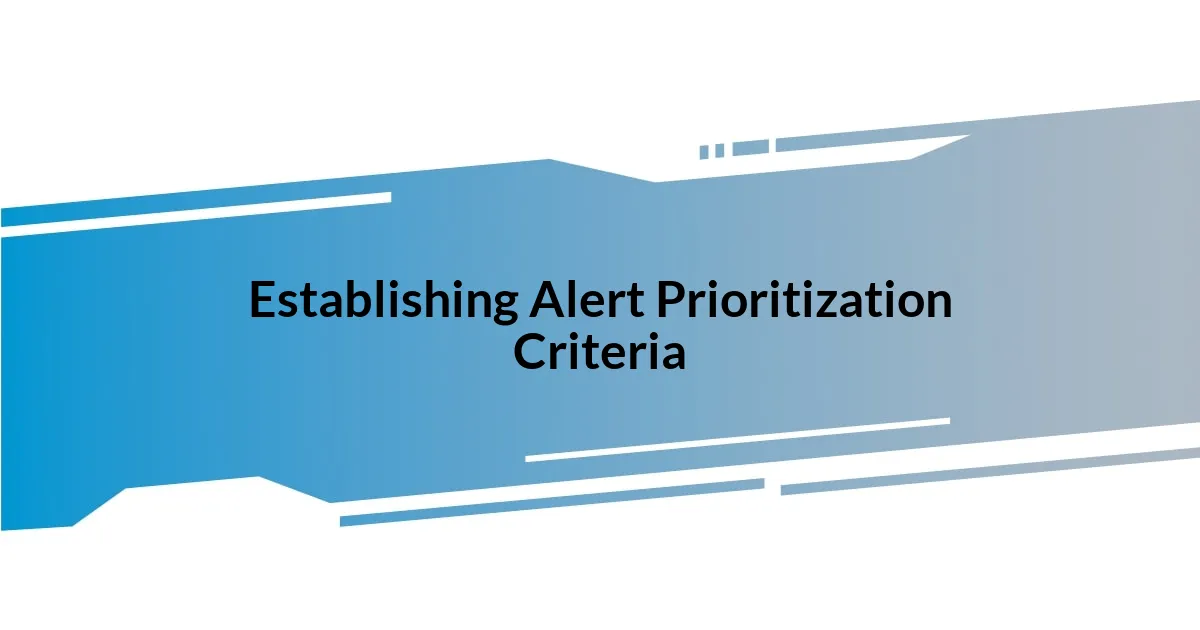
Establishing Alert Prioritization Criteria
Establishing prioritization criteria for security alerts is crucial in navigating the often chaotic landscape of cybersecurity. I’ve developed a simple yet effective way to evaluate alerts based on urgency, severity, and context. For instance, when I hear an alert indicating a data breach, my immediate reaction isn’t just alarm; I assess if it’s affecting sensitive data. This assessment allows me to focus on alerts that genuinely pose threats to our vital information, rather than getting caught up in the noise.
Another layer involves understanding the potential impact of the alert on our operations. One memorable instance was when we received an alert about unusual login attempts from a foreign IP address. Instead of scrambling, I reflected on our recent expansion into international markets. It turned out to be a legitimate attempt by a new partner. This experience underscored how effective prioritization not only minimizes stress but fosters informed decision-making.
I also classify alerts using a simple impact matrix, which helps visualize the priorities. Alerts that threaten critical infrastructure take the top spot, while those that indicate low-level system hiccups can wait. Creating this system has transformed how I approach a flood of alerts—it’s like having a roadmap in a thick fog, guiding me to what truly matters.
| Criteria | Explanation |
|---|---|
| Urgency | Immediate legal or operational threats requiring instant action. |
| Severity | Potential damage level to the organization (e.g., data loss, reputation). |
| Context | Background of the alert (e.g., recent changes in systems or user behavior). |
| Frequency | Repetition of alerts may signify ongoing issues. |
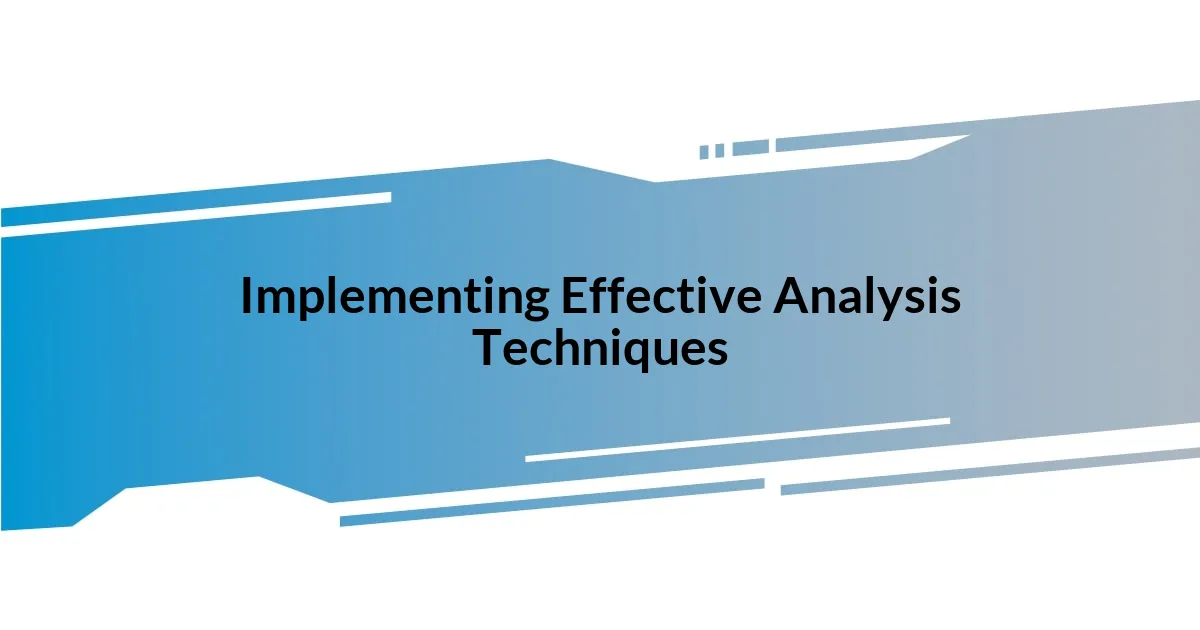
Implementing Effective Analysis Techniques
In implementing effective analysis techniques, I find it essential to go beyond just reading alerts; it’s about interpreting them in a way that becomes meaningful. When I encounter an alert, I take a moment to step back and consider the overall context—what’s happening in the organization or the industry at that moment? Once, I received an alert about a spike in outbound traffic late one night. Instead of assuming it was a breach, I first remembered that our sales team was conducting a major software demo. This reflects the significance of context; alerts are not standalone incidents but part of a larger narrative.
I also leverage tools that enable interactive analysis, making my job easier and more effective. Using dashboards with visual representations of alerts has been a game-changer for me. For instance, during a recent quarterly review, I realized that one type of alert was disproportionately represented. After delving deeper, I connected this to a specific software update that had inadvertently triggered false positives. This taught me that combining technology with my analytical skills not only speeds up the response but can transform the alert landscape into a tool for identifying weaknesses in our systems.
Often, I reflect on the importance of collaboration in my analysis process. Engaging with fellow cybersecurity professionals can yield insights that I might overlook. Once, after sharing a particularly perplexing alert with a peer, they offered a different perspective that led us to a deeper investigation. This collaborative effort not only resolved the issue quickly but reinforced the idea that two (or more) heads are certainly better than one. Have you ever had a moment where collaboration turned a challenge into an opportunity? I believe those instances are what make our field so dynamic and enriching.
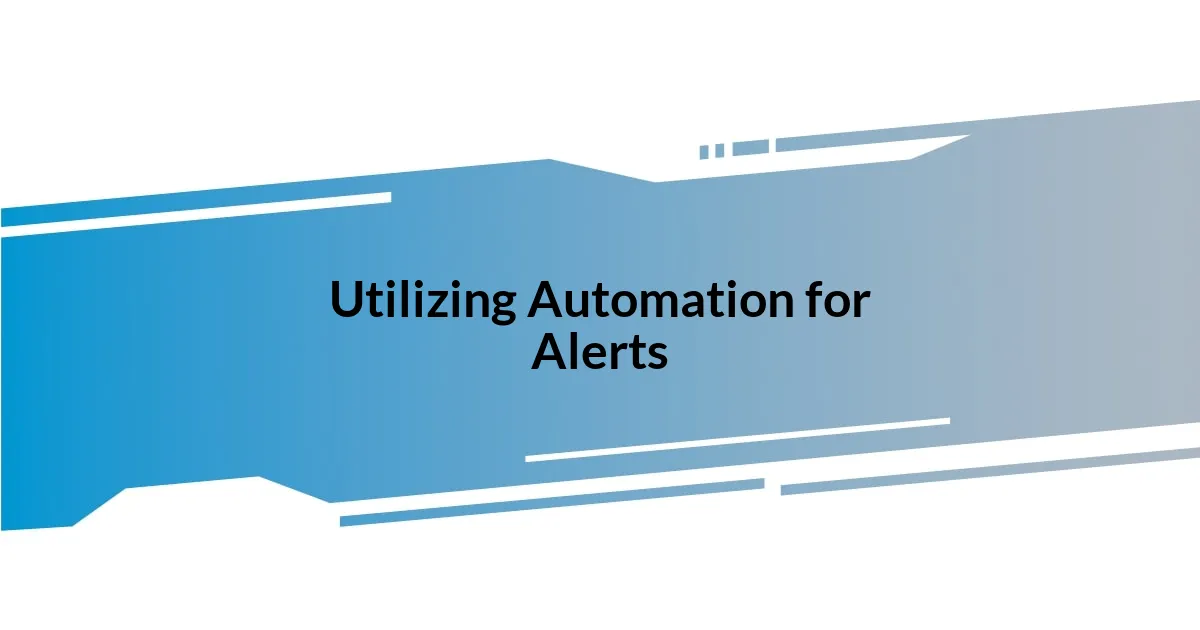
Utilizing Automation for Alerts
Automation has dramatically changed how I manage alerts, providing a vital buffer in a world overflowing with data. I once set up a rule that automatically flagged any alerts related to privileged account access. The first time an alert came through, I felt a mix of anxiety and excitement, knowing that automation had streamlined my focus. Instead of sifting through countless notifications, that system highlighted the most critical ones, allowing me to address issues with clarity and confidence.
In my experience, utilizing automated responses can significantly reduce reaction times. For example, if an alert indicates a potential SQL injection attack, I have scripts that can immediately quarantine the suspicious activity. The adrenaline rush of swift action is invigorating, and it reinforces my belief that automation isn’t just a tool—it’s my security ally. Do you remember a moment when technology saved the day in your role? I think those moments prove how invaluable automation can be in mitigating threats with impressive speed.
Moreover, integrating machine learning with automation takes alert management to another level. I’ve worked with systems that learn from previous alerts and improve their accuracy over time. The first time I witnessed an automated system correctly adjust its parameters based on historical data, I was seriously impressed. This evolution not only reduces false positives but also cultivates trust in the system’s recommendations. It feels like having a smart assistant that anticipates problems before they escalate. Isn’t that what we all want in the demanding field of cybersecurity?
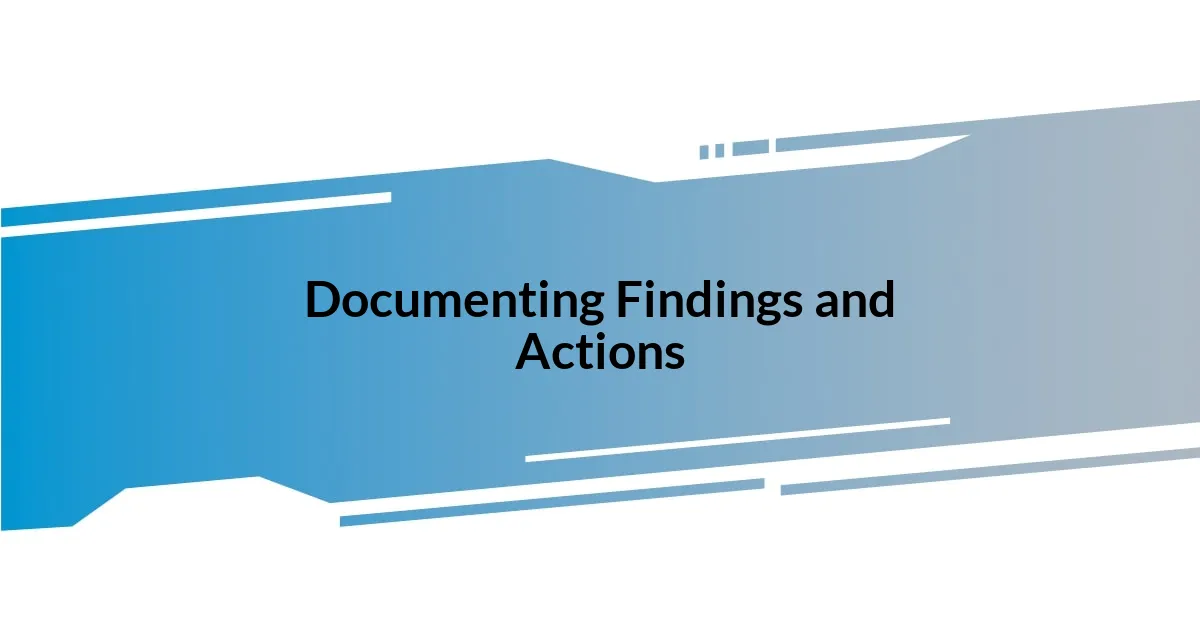
Documenting Findings and Actions
Documenting findings and actions is a crucial step in my security analysis process. Every alert generates a flurry of thoughts and reactions, and I’ve learned that capturing these in real-time can make all the difference later. I recall a situation where I noted down not just the technical details of an alert, but also my immediate thoughts and potential implications. That little extra effort helped during follow-up discussions, allowing me to articulate the context and reasoning behind our response.
When it comes to documentation, I prefer structured notes that include both the action taken and the results observed. This practice not only creates clarity for myself but serves as a valuable reference for my team. For example, after a minor incident, I documented the steps we took, which later became a part of our standard operating procedure. It’s rewarding to see how these documents not only prevent repeated mistakes but also guide new team members in navigating similar situations. Wouldn’t it be comforting to know that the lessons learned today can protect us tomorrow?
In my experience, maintaining a centralized documentation system fosters accountability and transparency. I vividly remember sharing a document with my team about an unusual pattern we noticed over several months. That collaboration led us to rethink our approach to monitoring. By engaging everyone in the findings and the subsequent actions taken, we built a stronger, more informed team that feels empowered to handle future alerts. Isn’t it amazing how documentation can turn an individual effort into a team triumph?
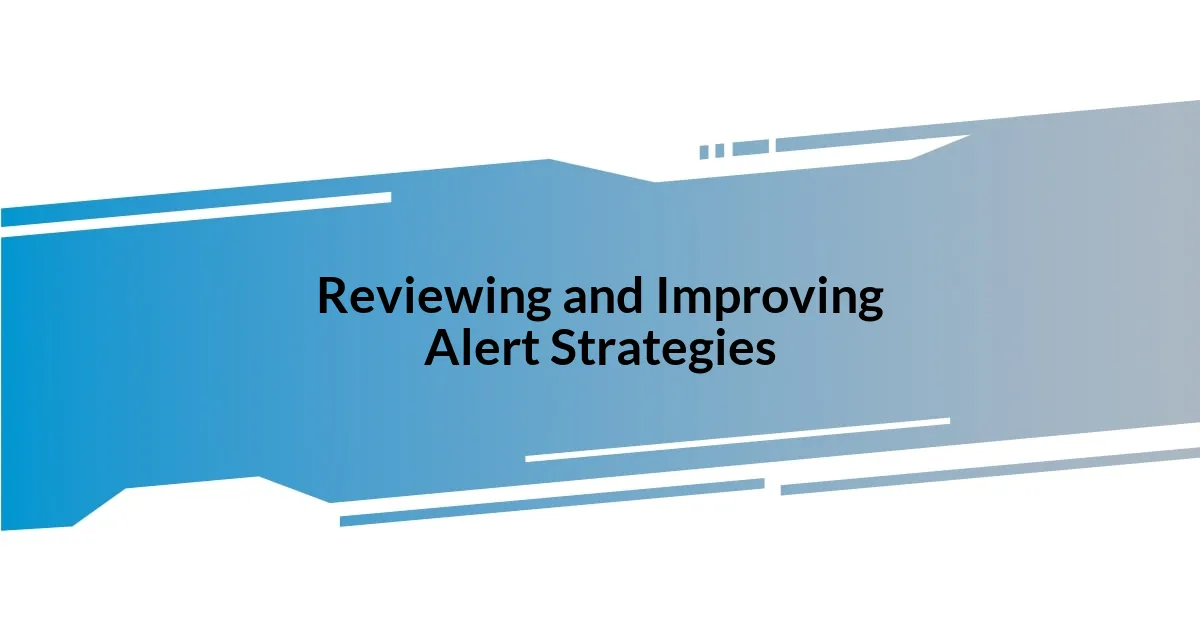
Reviewing and Improving Alert Strategies
Reviewing and improving alert strategies is an ongoing journey that requires reflection and adaptation. I’ve often found that after a significant security event, revisiting our alert criteria can reveal gaps in our detection capabilities. For instance, after a targeted phishing attempt, I gathered my team to evaluate our current alerts. We realized that specific patterns were missing, which led us to refine our threshold for what constitutes an actionable alert. This kind of review not only strengthens our defenses but also fosters a culture of continuous improvement.
One of my key practices in enhancing alert strategies is soliciting feedback from the entire security team during debriefing sessions. I still vividly remember a roundtable discussion where a junior analyst pointed out that certain alerts seemed too noisy, leading to alert fatigue. That insight changed my perspective entirely; it’s vital to consider the team’s experience with the alerts, as they’re the ones on the frontline. Have you ever felt overwhelmed by incessant notifications? I believe sharing these experiences can help reshape our alert systems to be more user-friendly and effective.
Creating a feedback loop is essential, as it encourages proactive adjustments to alerting protocols. I’ve implemented a system where every alert is reviewed and assessed after its resolution, often discussing its impact and the response it prompted. Each session feels like a mini-laboratory for solutions. Recently, we discovered that certain alerts, although valid, didn’t necessitate immediate action. By fine-tuning our strategies, we’re not just elevating the effectiveness of our alerts—we’re also enhancing team morale and efficiency. Wouldn’t it be fantastic if every alert worked in harmony, rather than causing chaos? That’s the goal I strive for in my approach.